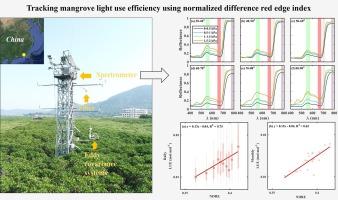利用归一化差异红边指数跟踪红树林的光利用效率
IF 7
2区 环境科学与生态学
Q1 ENVIRONMENTAL SCIENCES
引用次数: 0
摘要
红树林碳通量具有很强的时空异质性,因此很难在地点和区域尺度上准确评估红树林的碳预算。光利用效率(LUE)模型提供了一种前景广阔的遥感方法,然而,由于缺乏跟踪红树林光利用效率的可靠光谱指标,阻碍了碳通量与遥感测量的整合。为了弥补这一不足,我们基于对中国东南部亚热带红树林为期两年(2021-2022年)的塔式高光谱和涡度协方差(EC)数据的同步测量,研究了六种相关光谱指标(包括红边位置、红边反射率、红谷反射率、绿峰反射率、归一化差异植被指数和归一化差异红边指数(NDRE))跟踪冠层LUE的潜力。结果表明,红树林的LUE具有强烈的日变化和季节变化,其值随水汽压差(VPD)和气温的升高而下调。冠层光谱反射率曲线随季节而变化,在整个可见光/红边波段,反射率随 VPD 的增加而升高。在光谱指标中,发现 NDRE 是唯一在日和月尺度上与 LUE 有显著统计学相关性的指标,显示出 NDRE 与 LUE 的正线性关系。据我们所知,这是首次利用高光谱和 EC 测量同时探讨红树林 LUE 与红色边缘相关光谱指标在时间尺度上的联系的研究。本文所证实的 NDRE-LUE 联系为利用现成的卫星数据建立稳健的遥感方法以绘制红树林 LUE 和碳通量图奠定了基础。本文章由计算机程序翻译,如有差异,请以英文原文为准。

Tracking mangrove light use efficiency using normalized difference red edge index
Strong temporal and spatial heterogeneity of mangrove carbon fluxes makes it difficult to accurately assess mangrove carbon budgets at both site and regional scales. The light use efficiency (LUE) model provides a promising remote sensing approach, however, the lack of robust spectral metrics for tracking mangrove LUE hinders the integration of carbon flux and remote sensing measurements. To close this gap, here we examined the potential of six relevant spectral metrics, including red edge position, red edge reflectance, red valley reflectance, green peak reflectance, normalized difference vegetation index, and normalized difference red edge index (NDRE), for tracking canopy LUE based on two-year (2021–2022) simultaneous measurements of tower-based hyperspectral and eddy covariance (EC) data in a subtropical mangrove of southeastern China. The results indicated that mangrove LUE had strong daily and seasonal variations with the value down-regulated by increasing vapor pressure deficit (VPD) and air temperature. The canopy spectral reflectance curve changed seasonally showing elevated reflectance with increasing VPD over the entire visible/red-edge bands. Among the spectral metrics, NDRE was found to be the only statistically significant correlated to LUE at both daily and monthly scales, showing a positive and linear NDRE-LUE linkage. To the best of our knowledge, this is the first study to explore the links between mangrove LUE and red edge-related spectral metrics across temporal scales using simultaneous hyperspectral and EC measurements. The NDRE-LUE linkage confirmed here provides a basis for establishing robust remote sensing approaches to map mangrove LUE and carbon fluxes with ready-available satellite data.
求助全文
通过发布文献求助,成功后即可免费获取论文全文。
去求助
来源期刊

Ecological Indicators
环境科学-环境科学
CiteScore
11.80
自引率
8.70%
发文量
1163
审稿时长
78 days
期刊介绍:
The ultimate aim of Ecological Indicators is to integrate the monitoring and assessment of ecological and environmental indicators with management practices. The journal provides a forum for the discussion of the applied scientific development and review of traditional indicator approaches as well as for theoretical, modelling and quantitative applications such as index development. Research into the following areas will be published.
• All aspects of ecological and environmental indicators and indices.
• New indicators, and new approaches and methods for indicator development, testing and use.
• Development and modelling of indices, e.g. application of indicator suites across multiple scales and resources.
• Analysis and research of resource, system- and scale-specific indicators.
• Methods for integration of social and other valuation metrics for the production of scientifically rigorous and politically-relevant assessments using indicator-based monitoring and assessment programs.
• How research indicators can be transformed into direct application for management purposes.
• Broader assessment objectives and methods, e.g. biodiversity, biological integrity, and sustainability, through the use of indicators.
• Resource-specific indicators such as landscape, agroecosystems, forests, wetlands, etc.
 求助内容:
求助内容: 应助结果提醒方式:
应助结果提醒方式:


